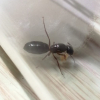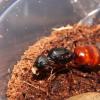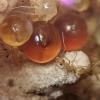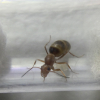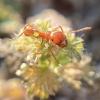I noticed some people on YouTube talking about videos of "army ants" but I was disappointed when they ants were not a species of dorylus. I (incorrectly) thought that only dorylus were true army ants. But it seems this name is more expansive and interesting than I thought. Being in an army is a way of life... not just a genetic group. But what are the essential characteristics of army ants? My current understanding:
- They need to march, well, like an army. They should not have permanent nests. But they don't need to form a bivouac necessarily. They could be mobile moving from treehollows to rock shelters instead.
- Unlike most ants army ants reproduce by splitting their colonies when they are large. Virgin queens who have no wings wait for the flying males to find them. The males are brought into the nest to mate.
Is there anything else?
This is a fascinating and seemingly effective evolutionary strategy. The most resource expensive colony members are not exposed. But perhaps there is a reason that only highly mobile colonies use this reproductive strategy. I've often wondered why "sausage flies" the male army ant are so large. They are smaller than the queens, but why not have super tiny males? Then they could produce more of them and one or two from a batch might have a better chance of finding a mate... This seems evolutionary extravagant to me look at how fat he is!
Alex Wild conveys the scale of these fatties in this great photo. Source: http://www.myrmecos....sense-of-scale/
I wonder in general why male ants don't take the super small route. They are often smaller than the queen and the advantage is obvious. Colonies with smaller males could produce more males. They can fly better than queens since they have less body mass. But male ants tend to be about 1/5 up to 1/2 the size of queens... you don't see male ants that are 1/20 the size of the queens even though ant biology can easily produce such extreme size differences within the same family. So why aren't male ants even smaller?
Do they need the size to muscle other male ants out of the way? Do they need body fat reserves to last a little longer and search a little further?
And why are "army ant" males so big ... relatively speaking?
Edited by futurebird, August 9 2021 - 4:41 AM.



